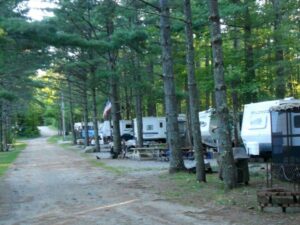Freedom—July 17, 2024—Freedom’s Planning Board on Thursday, July 18, will continue reviewing a site plan application submitted by Wabanaki Campground as part of its plan to sell lots to individual buyers in a cooperative-style “membership campground” ownership structure.
The meeting/hearing will be at 6:30 p.m. at Freedom Town Hall.
The site plan application seeks approvals to “make improvements to an existing campground, to include camp structure expansions, sanitary connections and improvements, etc.,” according to the meeting notice.
The conversion to a membership campground requires state and local approvals. Local approvals must be obtained before the state takes formal action on the conversion application, which was submitted in January.
The business has 67 campsites, an apartment building with four units, nine cabins, and a lodge, according to campground manager Mark Salvati, who is also the principal of Wabanaki Campground Conversion LLC, which has applied for the approvals.
Salvati says the intent is to aggregate all structures, to be called “units,” under the joint ownership of a cooperative corporation, for a total of 77 units.
The Planning Board began its design review of the site plan application on March 21 with a presentation by Bryan Berlind of Horizons Engineering, one of the campground’s agents.
Berlind presented plans for five building additions to the site’s “hutniks,” structures that the meeting minutes described as “Wooden tent, sinks are outside. Not insulated or heated.”
The hutniks are not connected to a septic system. Confusingly, the conversion application submitted to the state references six hutniks, not five, as part of nine “cabins.”
In an April 25 letter to the board, Berlind requested a waiver of the requirement to provide a “50-year storm evaluation” for the impervious areas created by the proposed hutnik expansions.
The waiver request appears to pertain to Section 7.4 of the Site Plan Review Regulations, which requires that the applicant “make adequate provision for storm water facilities which shall be designed to handle one hundred (100) year storm events,” not 50-year events.
Horizons called the proposed increase in impervious areas “insignificant,” making the stormwater evaluation “unnecessary.” The board has not ruled on the waiver request.
Septic System and Occupancy Questions
Runoff from the campground may prove to be one of several important discussion points in evaluating the site plan application.
Research on the campground’s history revealed that a 16-lot subdivision plan was approved by the town in 1970 for owners Elmer and Janice Franson. The plan shows an extensive drainage system of catch basins and culverts leading directly into Ossipee Lake. The current state of the drainage system is not publicly known.

Screen shot from Wabanaki Campground’s website shows campsites at the Ossipee Lake property.
The subdivision plan was amended in 1977 to define it as single-family residential homes of no less than 800 square feet, each home with its own septic system and served by a community water system. Camping was prohibited.
It is unclear when the Fransons began renting campsites for trailers. But on May 9, 2000, DES notified the couple that they were in violation of state laws by operating 80 campsites without an approved septic system or state subdivision approval for a campground.
After a second notice did not produce a response, DES on February 19, 2001, ordered the couple to cease operation of all campsites and obtain state subdivision approval by February 28, obtain construction approval for the campsites by March 15, and obtain operational approval for all septic systems by April 10.
DES issued a Recreational Campground Compliance Certificate in June that year. It stated approval for “69 potential campsites” and approved 50 of those sites to be occupied. The certificate also approved two septic systems to serve the 50 sites approved for occupancy.
A third system shown in the applicant’s 2001 plan was not built at the time, but was built this year.
The research leaves unanswered how the business was able to operate as an 80-site campground between 1977, when it was approved as a residential subdivision for single-family homes, and 2001, when DES ordered the business to cease campground operations and apply for state approvals.
It also raises the question of whether the property’s two septic systems approved in 2001 for 50 campsites have been used for the past 23 years to provide sanitary services to all 67 campsites on the property.
The Planning Board last month voted to hire an independent third party to assist with reviewing the Wabanaki application. Horizons Engineering’s Berlind asked that the review be limited to the expansion of the hutniks and their connection to the septic system.
The conversion application caught the attention of the lake community earlier this week after DES and the Department of Safety said they are reviewing the number of boat docks and moorings at the site for compliance.
Lake resident Dr. Anthony Raynes, who is a campground abutter, wrote to the town to express his concerns about the growing number of boats and other environmental issues.
“We have recently seen trees cut down on the property close to the lake, and we are aware of how important the storm water drainage plan requirement is to prevent damage to the lake,” he wrote.
“We do not understand the request for a waiver of [storm water] compliance,” he said.
“We are not convinced that the new Cooperative Board wlll take this weighty responsibility seriously.”

Oversight to assure clean lake waters is job #1. And quite frankly, given the pressures for expansions and construction within the purview of streams, rivers, ponds and lakes the Departments of the State of New Hampshire must be overwhelmed. This is where tendencies and decisions go south.